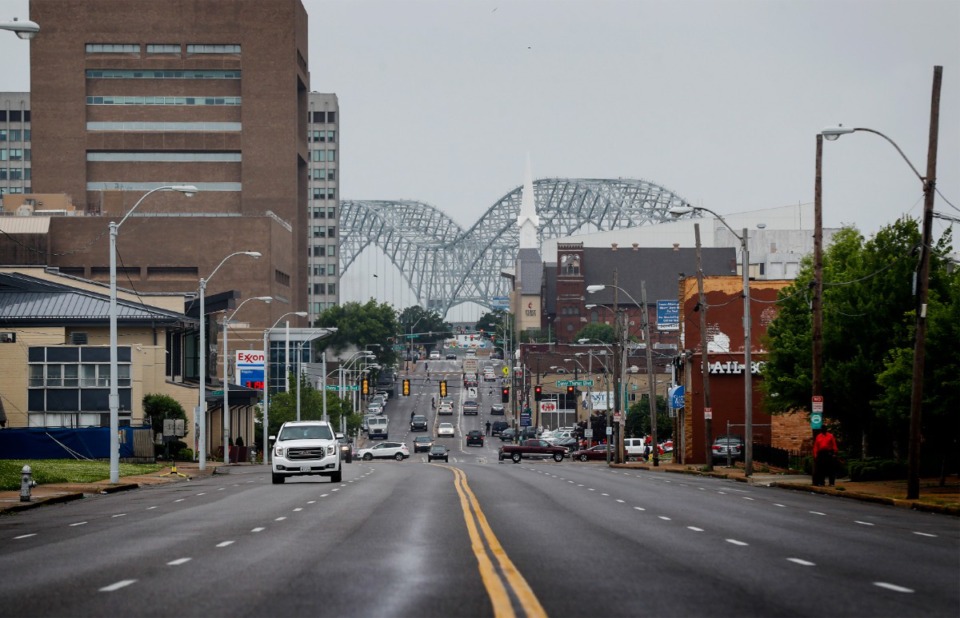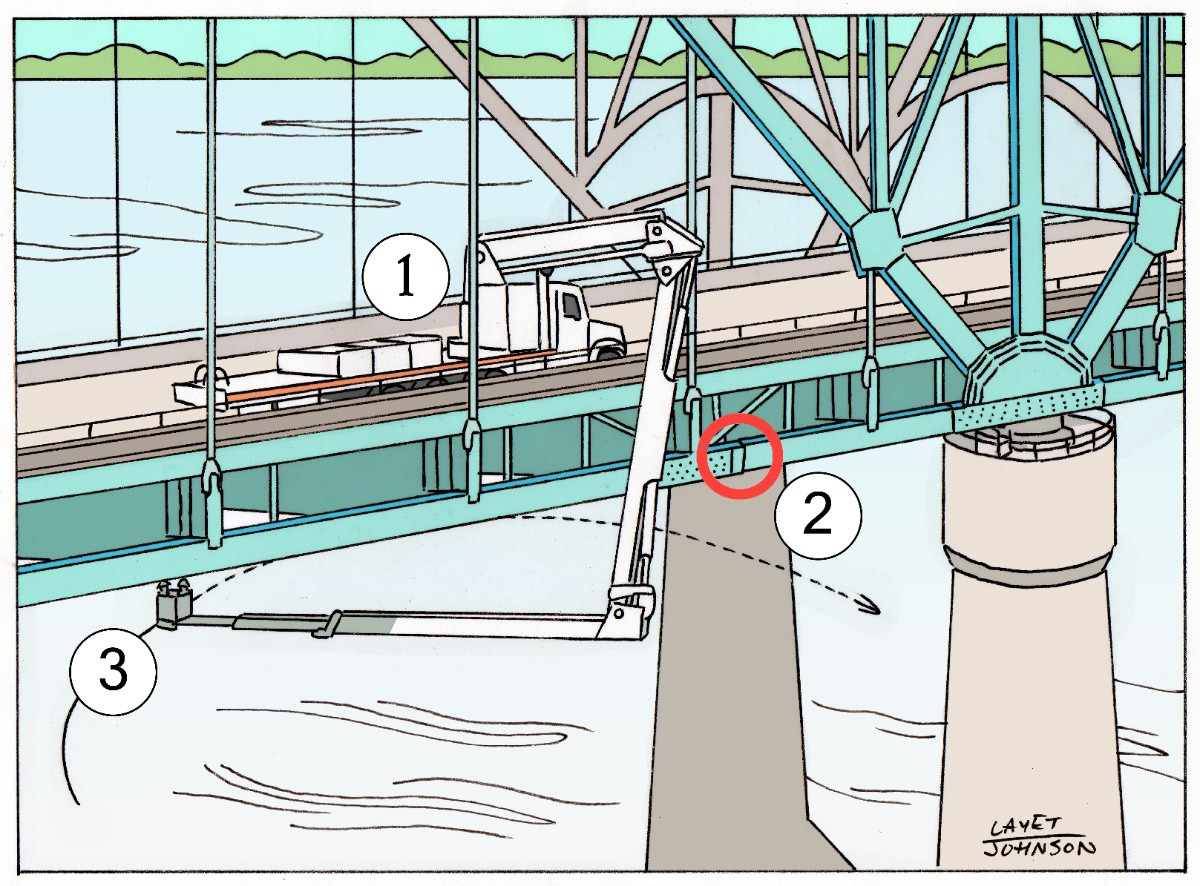
This story was co-published with The Daily Memphian.
Though I-40 traffic is now flowing over the Hernando DeSoto Bridge for the first time in almost three months, officials with the Arkansas Department of Transportation have yet to explain how its inspection program missed the potentially catastrophic crack that closed the bridge in May.
An investigation by the Arkansas Nonprofit News Network and The Daily Memphian found that ArDOT lacks a detailed, explicit description of exactly how the next inspection of the DeSoto bridge should unfold. And that inspection, according to ArDOT officials, will happen as soon as September.
When asked for documentation of its inspection procedure, ArDOT spokesman Dave Parker provided a single file produced in 2012. The four-page document, titled “Fracture Critical & Complex Bridge Inspection Procedure — Mississippi River Bridge No. 05141 Into Memphis," describes basic structural elements of the bridge and notes it was constructed using a welding process that may be prone to cracks. In three diagrams and fewer than 200 words, the document outlines the process of inspecting a bridge that spans nearly three miles.
Asked what prompted ArDOT to institute the protocol in 2012 and how inspections changed as a result, Parker replied: “Additional time would be needed to research the history and reasoning behind protocols made this many years back.”
Parker also referred reporters to the Federal Highway Administration’s bridge inspector’s reference manual — a 2,000-page volume that outlines general requirements and procedures not specific to the DeSoto Bridge.
The agency also does not yet have a plan for how to ensure such a profound failure never happens again. “The FHWA review is not complete. ARDOT will make changes in collaboration with FHWA,” Parker said, referencing a Federal Highway Administration audit of ArDOT’s inspection program that is expected to conclude in September — one of two ongoing federal probes examining the program in the wake of the bridge closure.
Experts interviewed by ANNN and The Daily Memphian said bridge inspection protocols should be clear and precise.
“The Department of Transportation should — must — have directions to people doing inspections as to what their obligations are, and that they ought to be able to provide,” said Raymond Tillman, a licensed professional engineer and past president of a division of the American Road and Transportation Builders Association.* “You don't just tell someone ‘Go out and inspect this.’ You say, ‘Look at A, B, C and D.’ ”
Tillman emphasized that his comments were about inspections generally and that he did not evaluate Arkansas’s specific program.
The lack of specific directives are of particular concern with the DeSoto Bridge because it remains unclear whether the inspection crew was able to closely view every part of the bridge using the tools at their disposal.
The DeSoto Bridge inspections require “arms length” access to sections of the structure categorized as “fracture critical,” meaning the failure of a member would likely lead to the bridge’s collapse. Adel Abdelnaby, an associate professor of engineering at the University of Memphis, said that means a bridge inspector must be close enough to every fracture critical element that he or she can literally reach out and touch it.
That apparently did not happen on the DeSoto Bridge, which developed such a large crack in one of its steel tie girders — fracture critical beams that run along the bottom of the bridge — that the fissure was visible from the surface of the Mississippi River, some 120 feet below. Amateur photographs indicate the crack has been visible since at least 2016 and perhaps earlier.

Abdelnaby, who previously worked as an bridge inspector in Egypt, said it’s routine for inspectors to discover they’re unable to access a part of a bridge when they’re out in the field. But those places must be rigorously documented and followed up on.
“Sometimes you miss certain areas,” he said. “You can't access them for safety reasons, or because they're not accessible, or because you don't have the equipment, or because you don't have the training. So you have to go back and point this out in the report. … And then they’re either going to send you back with the right equipment to inspect that part, or they can send someone else to do it.
After the crack was discovered, Abdelnaby said, he reviewed ArDOT inspection reports from recent years and saw no mention of parts of the bridge being inaccessible. He also reviewed the 2012 document from ArDOT.
“I really wish there was more transparency,” he said. “And they would mention exactly what the protocol is, and what the inspector was asked to do.”
“Each bridge is unique, and each one has a very specific way of achieving a hands-on inspection,” said Gary Prinz, an associate professor at the University of Arkansas who specializes in steel fatigue and fractures. “Some you can just walk underneath it. Others, it’s a more difficult process.”
State Sen. Jonathan Dismang, a prominent Republican lawmaker who has criticized ArDOT in the past, said the evident lack of a detailed protocol for DeSoto Bridge inspections is consistent with larger issues within the agency. In 2019, after the passage of a new sales tax devoted to road construction and maintenance, a legislative subcommittee co-chaired by Dismang hired a consultant to review ArDOT’s practices and make recommendations.
Dismang was careful to note the legislative study didn’t look at the bridge inspection program specifically. But agency-wide, he said, the consultant found a lack of consistency and documentation throughout ArDOT.
“As you go through [their] report, it's just kind of like it'll hit you in the face — there's not a defined process in place, or there's not an understood expectation. Things are so siloed that the right hand’s not talking to the left hand,” he said.
***
By all indications, the DeSoto Bridge is now safer than it has been in years. The fractured steel tie girder has been removed, crews have combed the structure from top to bottom, and a contractor hired by the Tennessee Department of Transportation has reinforced several spots as a precautionary measure. (TDOT and ArDOT share maintenance responsibilities for the bridge, but only ArDOT performs inspections.)
But ArDOT’s bridge inspection program remains under a cloud. In addition to the Federal Highway Administration audit, the U.S. Department of Transportation’s Office of Inspector General is also reviewing the program. ArDOT is conducting an internal investigation into its bridge maintenance division personnel, but ArDOT Director Lorie Tudor — along with other ArDOT officials — laid blame squarely on one bridge inspector: Monty Frazier, the team lead on its DeSoto Bridge inspections in 2019 and 2020. He was also part of the crew in 2016, 2017 and 2018 inspections, though not the lead. Frazier was fired on May 17, and no other ArDOT employee has been terminated or disciplined to date.
In an interview, Tudor said Frazier had been “the only inspector who looked at that particular tie girder” in the past six years.
That story is undermined by ArDOT’s own inspection reports, which indicate at least four other employees played a role in inspecting the tie girders since 2016. The 2018 inspection report does not even list Frazier as one of the two employees responsible for that element of the bridge. (Two other employees’ initials are present on the document, one of which appears to be that of Rhett Franks, the team lead that year.) And, another recently discovered amateur photograph appears to show the crack in 2014, before Frazier even worked for ArDOT’s heavy bridge inspection program.
The DeSoto inspections were performed with the aid of a piece of specialty equipment called a “snooper truck,” a massive vehicle with a long, adjustable arm ending in a basket large enough to carry inspectors underneath the bridge. ArDOT has suggested Frazier should have been able to reach the cracked portion of the tie girder with the snooper. But Frazier has said he believes he was using the equipment as he was trained to do.

2. The crack was found on one of the steel “tie girders” that runs the horizontal length of the bridge, several yards below the roadtop. Photos from the 2020 inspection apparently showed no sign of the crack on the bottom face of the tie girder at that time.
3. A basket at the end of the arm carries inspectors in an arc beneath the bridge, allowing them visual access to the underside of the structure.
(Illustration by Layet Johnson)
Tillman, the engineer, said the snooper truck is only one of many tools for bridge inspection. If it couldn’t be used to get an adequate view of every foot of the tie girder, the inspectors should have done something differently, he said.
“If that was the case, and they couldn't get a good view of the outside faces of the structure, then they just swing a separate little deck affair over the side, so they can view it,” Tillman said. “Absent that, drones or binoculars from a distance. But obviously, they have to be viewed.”
The ArDOT inspection reports, he said, should describe whether the crew could clearly see the tie girder and what methods they used to view it.
The reports, however, contain few such details. In the 2020 report, the only narrative description in the section of the report that includes the cracked tie girder is the following: “Steel arches [have] flaking rust at spring line where members flatten out. Paint system is failing and is chalky colored. At diagonal juncture, gusset plates and various locations [have] freckled rust. This is typical throughout steel arches.”
The description was no more detailed in 2018, the year that Monty Frazier was not one of the inspectors tasked with examining the tie girder: “Span B, U-12, Left, Rib Top Splice Plate: One sheared bolt and one missing bolt. Paint system is failing with areas of minor corrosion. No apparent visible cracks or changes at this inspection.”
In contrast, a 2019 report from a separate inspection of certain portions of the bridge, conducted by independent contractor Michael Baker International, includes a daily log of activities and a systematic checklist of each component inspected. (ArDOT hires Michael Baker to inspect only the parts of the bridge located above the road deck. The crack that closed the bridge in May, located below the road deck, was discovered by a Michael Baker employee.)
Karl Frank, a professor emeritus at the University of Texas at Austin's Department of Civil, Architectural, and Environmental Engineering, put his opinions about ArDOT’s bridge inspections bluntly.
“They just did not inspect it,” he said. “They did not get over the side of the bridge to look at this. They’re supposed to actually get their hands on it. That’s why they call it a ‘hands-on inspection.’ They simply didn’t do it. So, something is wrong with the inspection program in Arkansas. This was a failure of the inspection program and it’s really terrible.”
Dismang, the Arkansas state senator, said ArDOT needed to reckon with the failure. Despite the near-catastrophe on the DeSoto Bridge, he said, ArDOT remains reluctant to acknowledge fault.
The attitude at the agency, Dismang said, is “kind of this defiant — ‘Yeah, something went wrong, but nobody’s hurt. It’s not a good thing, but, you know, we’re fixing it. So everything’s good.’”
*An earlier version of this story incorrectly identified Raymond Tillman as a past president of the American Road and Transportation Builders Association as a whole, rather than a division of the association.
This reporting is courtesy of the Arkansas Nonprofit News Network, an independent, nonpartisan news project dedicated to producing journalism that matters to Arkansans.